

Jon Clements, Author (unless otherwise noted) and Editor
The way I see it (apple maturity report)
2017 pest management season high/low-lights and significant observations
New England Vegetable & Fruit Conference, December 12-14, 2017, Radisson Hotel, Manchester, NH. Press Release and http://newenglandvfc.org for more information.
Jon Clements
Harvest is about 2/3 (or more) done. It has been good weather, althought it is getting dry. One more weekend of good weather should do us all good. There is a near-record crop, as noted in this Worcester Business Journal article. Let's hope a good summer was able to produce fruit buds for next year.
Apple maturity report for October 3, 2017 Healthy Fruit
Note: target maturity indeces: red color, >50%; firmness, >14 lbs.; soluble solids, >12; DA, 0.60 to 0.40 for Honeycrisp, 0.65 for Gala, 1.00 for Golden Delicious, 1.15 to 1.00 for Red Delicious (higher DA = more "green"); starch index, 4-6.
| Date | Variety |
Drop? |
Diameter (inches) |
color (% red) |
Firmness (pounds) |
Soluble Solids |
Starch Index |
DA Reading |
Comments |
| 2-Oct, 2017 | nil |
2.9 |
75 |
17.7 |
13.7 |
6.5 |
0.42 |
nice, some scab, off plant patent now, you should be planting some, tastes like a fruit salad | |
| 2-Oct, 2017 | none |
3.05 |
95 |
17.2 |
12 |
4-6 |
NA |
Royal(?) Empire, very nice, ready to pick for storage | |
| 2-Oct, 2017 | Golden Delicious (Gibson) |
none |
3 |
NA |
14.3 |
13 |
6-7 |
1.39 |
could start harvest despite appearing quite green |
| 2-Oct, 2017 | some |
3 |
100 |
14.6 |
14 |
4-8 |
NA |
should have been picked by now, quality will deteriorate rapidly | |
| 2-Oct, 2017 | Cripps Pink (Maslin cv.) |
some |
3.2 |
80 |
15.3 |
14.4 |
5-6 |
0.47 |
lightly cropped trees should be picked |
| 5-Oct, 2017 | nil |
3.2 |
60 |
14.2 |
13.6 |
7 |
0.64 |
some watercore, need to be harvested |
Jon Clements and Elizabeth Garofalo
The weather in 2017 could largely be classified as benign except for the few orchards that received significant hail damage. (BTW, sign-up deadline for crop insurance is November 20. But it was kind of wet most of the season, so we saw more scab than we would have liked. What follows are some significant orchard pest observations in 2017.
Diseases
Primary apple scab season was fast and dirty this year. Too bad we can’t say the same for all those secondary infections many of you have been fighting. All. Summer. Long. RIMpro has us (UMass Cold Spring Orchard) down for 7 significant -- significant is a relative term here, in a “clean” orchard a RIM value at or above 300 is considered significant, in an orchard with high inoculum potential, any primary event should be considered significant -- infection events beginning about April 20. We had a stretch of app. 4 overcast, wet and rainy days that week. This infection event was confirmed as the first of the season in our potted scab "trap" trees as well. The final primary infection event, for RIMpro’s Belchertown site, was the event that occurred around May 26. Again, we had a few days running of wet, cool weather. This final primary infection event was also confirmed in the potted trap trees. This may have been the one that caused a lot of people trouble all summer long. UMaine’s AgRadar provided us with similar predictions for the season.
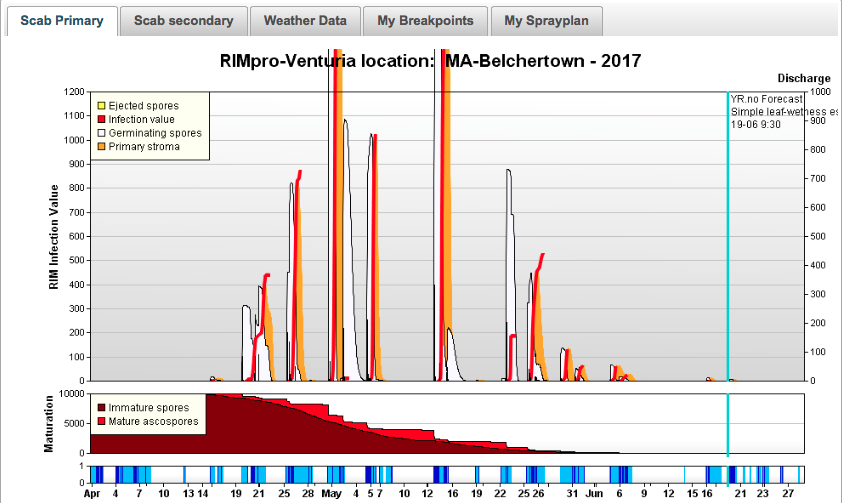
2017 apple scab season as visualized by RIMpro
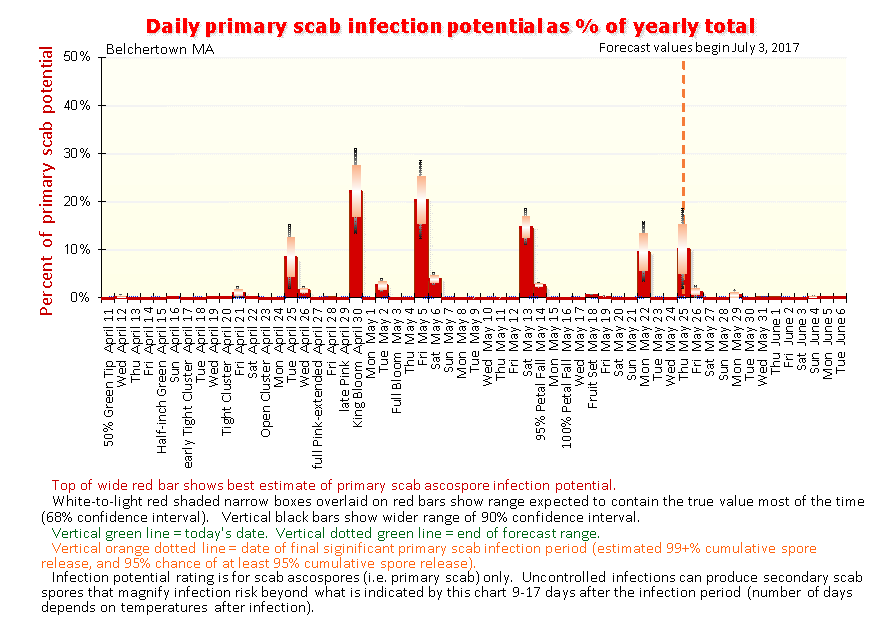
2017 apple scab season as visualized by AgRadar
Powdery mildew was certainly out there, kind of surprising given the wet weather. Remember to include fungicides good on powdery mildew in your mid- primary scab season sprays.
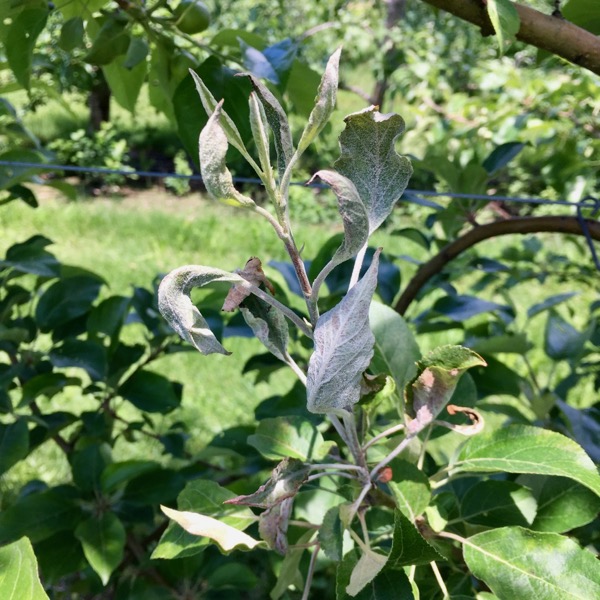
Powdery mildew on apple foliage, 7-July
What made for perfect scab weather, however, was not favorable fire blight weather apparently. We literally couldn’t infect blossoms on purpose this year. As a matter of fact, the weather during bloom was so bad that some folks worried fruit set might be diminished. Thankfully, that was not the case. There were some scattered reports of fire blight in MA, but they did not appear to be associated with bloom time. The hail that swept through parts of the state in late June likely had something to do with these strikes.
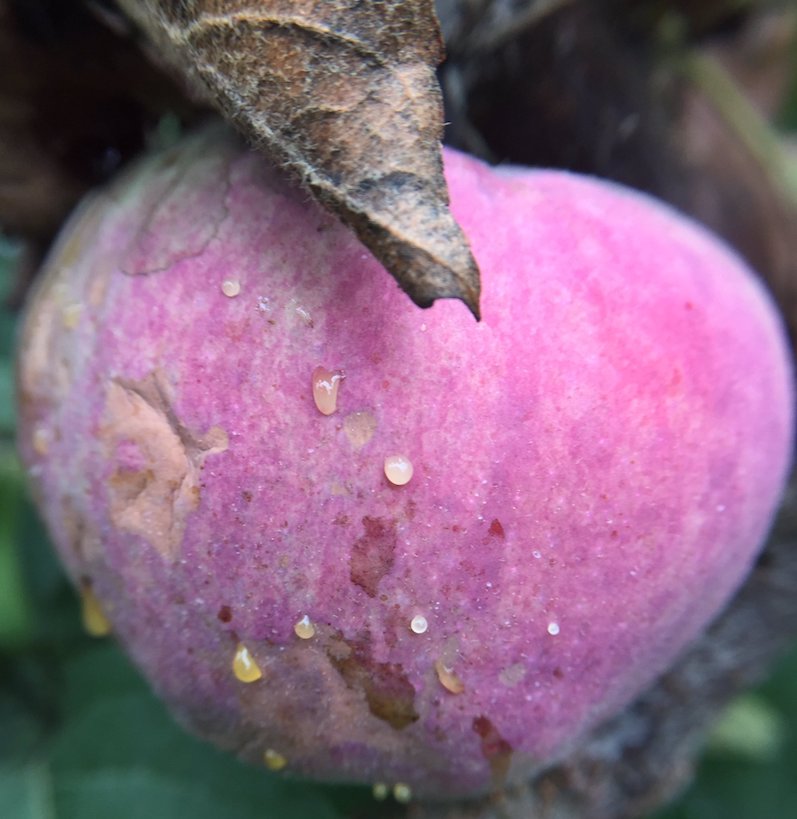
Mid-season fire blight "ooze" on apple fruit
Fabrea leaf spot was more prevalent this year than in the last 3 or 4. But, we already went over that in a recent Healthy Fruit. No need to belabor the point.
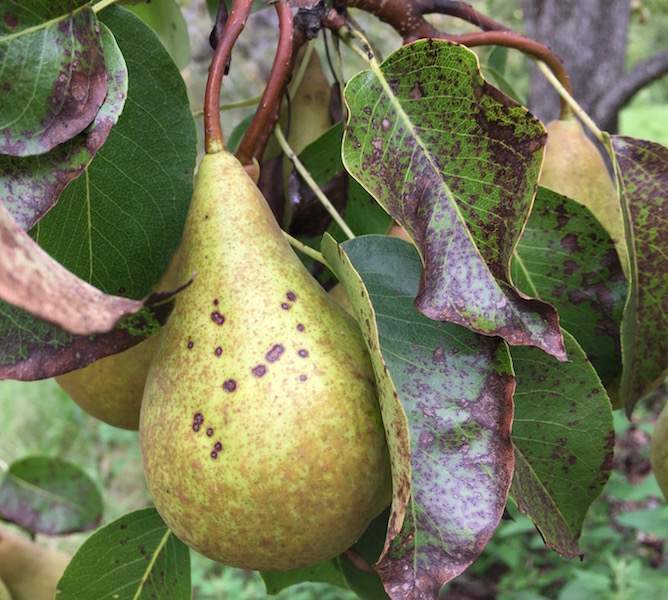
Bad case of fabraea leaf spot on Bosc pear, early September, 2017
Phytophthora...seemed to pop up in a few young apple plantings. Many theories abound how/when/where it came from, but it was a wet spring so it is no big surprise. As always, if you even THINK a site might be too wet for planting fruit trees, it is DEFINITELY too wet! But phytophthora can even afflict good sites, as pictured below. Planting on berms is something to think about, as would be treatment with Ridomil and/or phosphite-type fungicides (Rampart, etc.). Phytophthora-afflicted fruit trees are depressing...
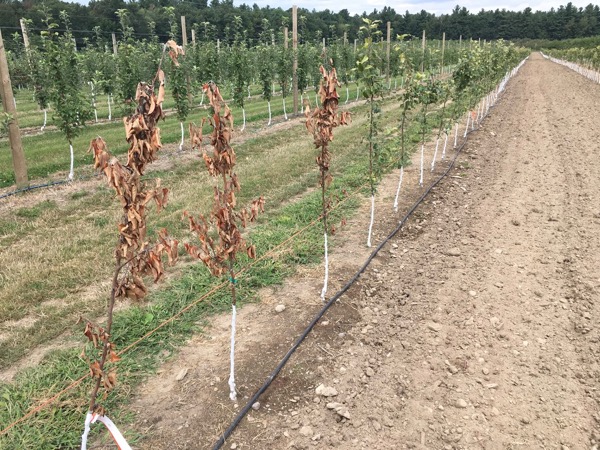
Phytophthora infected newly planted apple trees in foreground
Marssonina leaf spot was observed and positively identified at the UMass Orchard, something to be on the lookout for in coming year. Necrotic leaf blotch of Golden Delicious was also quite common.
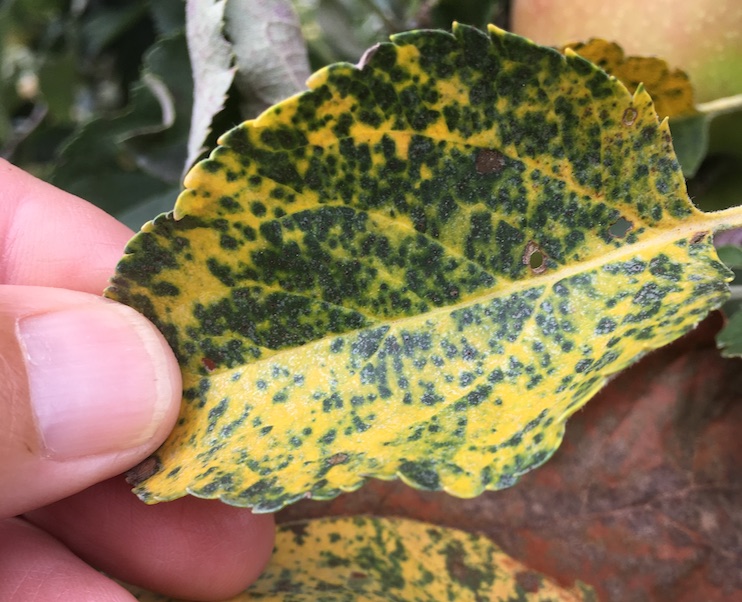 |
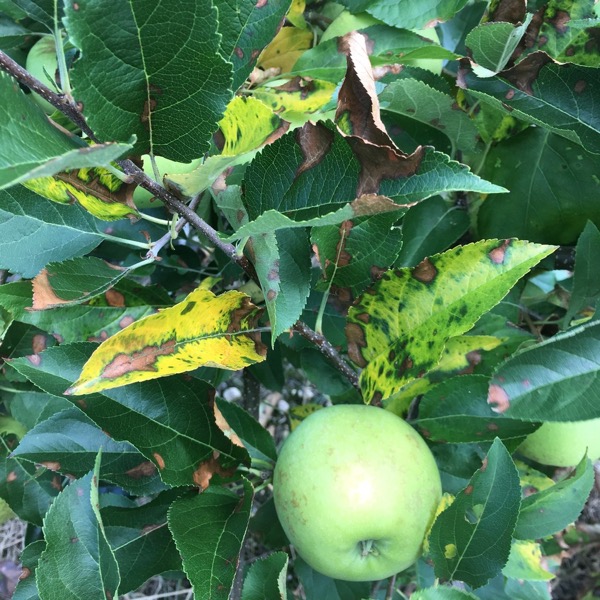 |
Suspect Marssonina leaf spot on Jonagold apple, 18-Sept (right) and necrotic leaf blotch on Golden Delicious
Almost forgot about brown rot, how could WE?! Not to harp to much on the wet, wet year we had, BUT, all that wet weather really made for some spectacular brown rot infections. Stone fruit are finicky enough, why give brown rot any help by leaving it in the orchard? Be sure to remove mummies as best you can to reduce the amount of inoculum in the orchard. This is another one of those times where opening the canopy up (you're pruning anyway) to allow air circulation will help mitigate disease pressure by increasing air circulation.
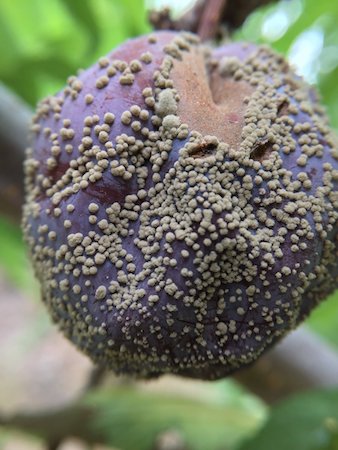
Brown rot on plum
Insects
Kind of a ho-hum year with a few exceptions...
Gypsy moth ravaged a few locations. Significant foliar chewing occurred and sprays had to be applied (and blueberry flower buds were really hammered)! A couple of timely early applications of DiPel (or another Bt material) handled this critter nicely in some locations. The silver lining to this wet cool(ish) spring and summer: the fungus that attacks gypsy moth larva in the wild has finally had a chance to build inoculum levels back up enough to kill the little buggers. Plenty of them survived to lay eggs though. Next year, with any luck, the fungus will get them before they move into your orchards. Early season DiPel applications, especially on young trees and other susceptible plantings, will be good insurance to protect you against the possibility that the naturally occurring bio control isn’t enough to keep GM at bay. It will also knock down other lepidopteron larva chewing things up at the same time (bonus!)
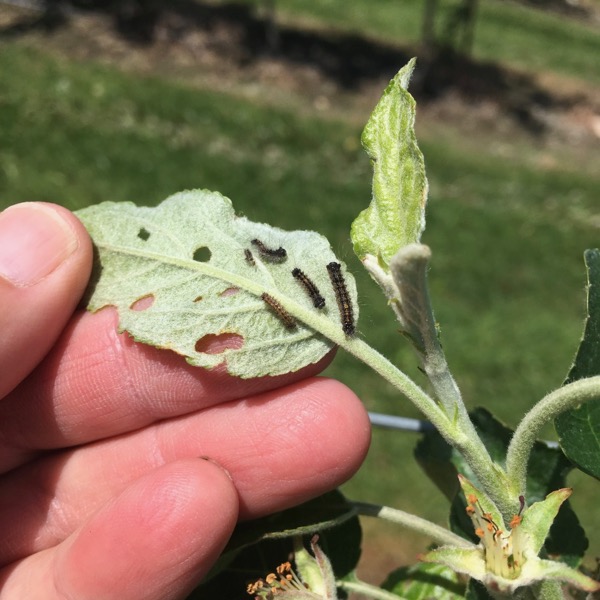 |
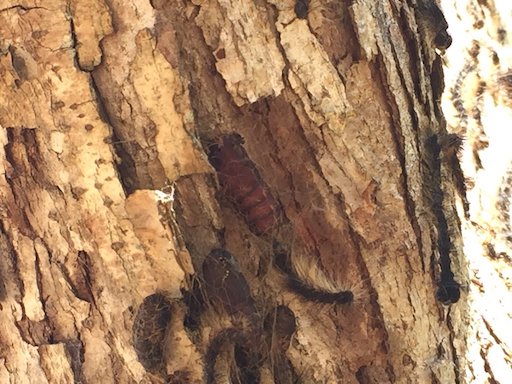 |
Plum curculio were sparse initially, but made a good push in late May, but relatively easily controlled.
.jpg)
Relatively fresh plum curculio damage observe on 19-May
Internal fruit feeders (Oriental fruit moth, codling moth) and leaf rollers were out there based on our statewide pheromone trap network (part of our iPiPE Northeast Apple Crop Pest Program, and monitored by undergraduated student interns Nicole Foley and Paul O'Connor), however, they must have been readily controlled by insecticide sprays, as very little actual fruit damage has been observed.
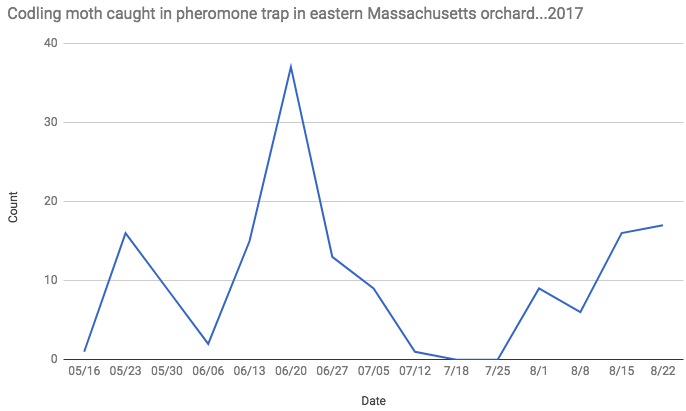
Spotted wing drosophila (SWD) reared its ugly head (err, ugly ovipositor?) earlier than usual this year. Our first trap captures were the week of June 27 (in cherries), about a month earlier than in 2016. Normally, we don’t worry about SWD in tree fruit but this year we had -- for the first time around here -- a significant problem in cherries. At least one orchard lost pretty much all their cherry crop to SWD. This one bears watching. Insecticide treatment is probably going to be necessary in cherries in coming seasons. Trapping to establish that this pest is in fact present in the orchard and specific crop is a critical first step to management. Bear in mind the early season population build up we experienced this year is, thus far, an aberrant event. When pruning for the coming season, keep in mind a good open canopy will increase air circulation (good for reducing disease and SWD pressure, bonus!) and spray penetration when making pesticide applications.
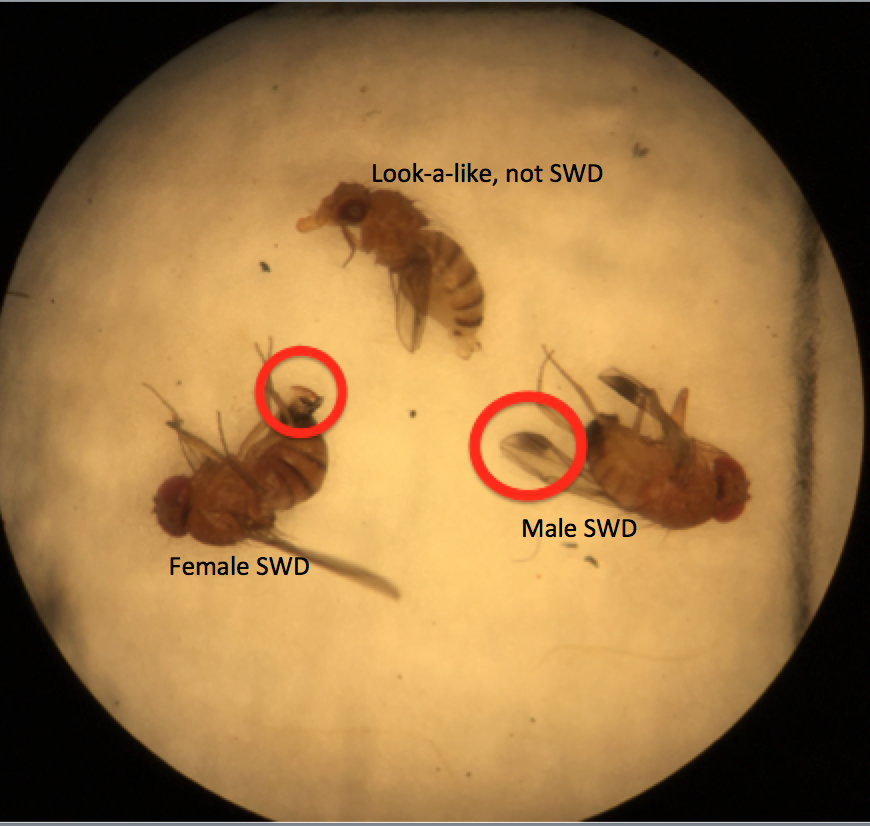 |
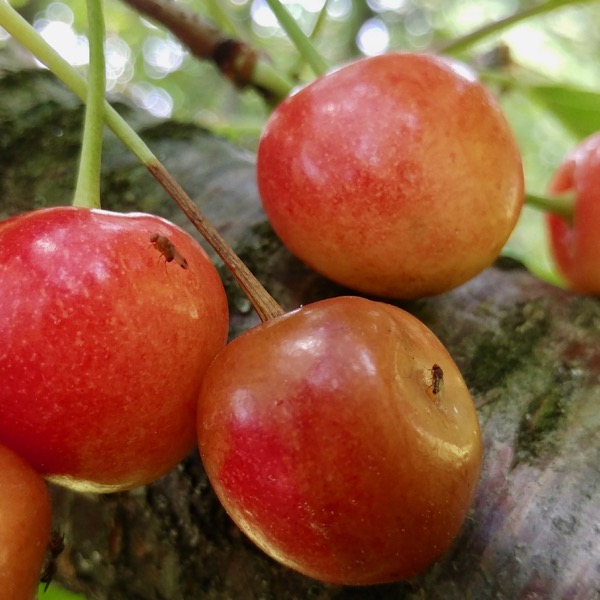 |
Potato leaf-hopper came sweeping up from the south again this year. You can still now see the damage on shoots. Next year, it will be like it never happened. Until they get here again. Older trees seem to bear the damage with no problem. Hopefully your newer plantings were protected. Those are more vulnerable to lasting damage by PLH.
Brown marmorated stinkbug BMSB. Every year we expect it to be THE YEAR. Thankfully, thus far we have been disappointed. While we have seen an uptick in home-owner reports this fall, we have not been able to confirm economic damage in the state from this pest. Many of our pheromone traps turned up empty all season long. There were a few exceptions. Traps in known hotspots, generally close to neighboring states where economic damage has been documented, caught a few. We still have not seen traps any where close to threshold. We have seen them in ornamentals. Continued trapping and monitoring for this insect will remain important for future management considerations. Rumor has it natural predators may be keeping BMSB at bay in wild settings. Season-long insecticides sprayed in orchards can't hurt. Note: in neighboring states, New Hampshire and Connecticut, there have been significant trap catches. 100's in a trap in CT. Thanks George Hamilton and Mary Concklin for sharing your BMSB trap catch data.
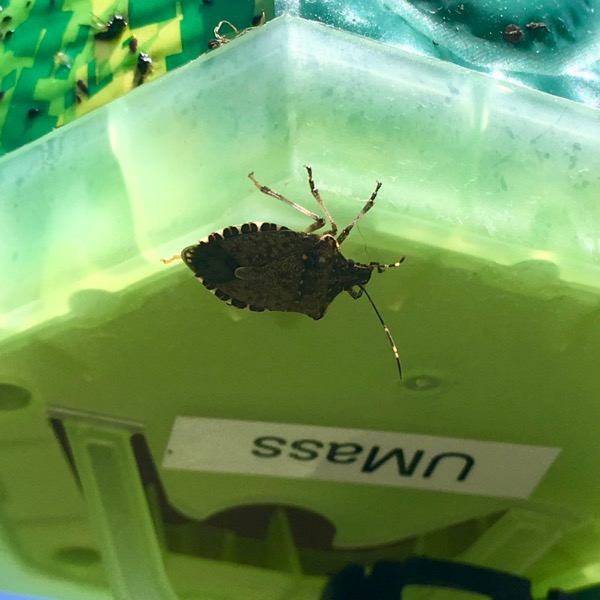 |
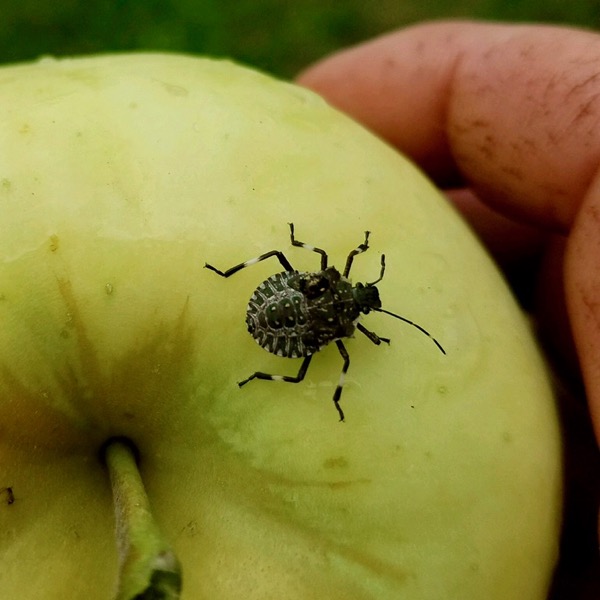 |
BMSB adult on Rescue Wasp trap baited with BMSB pheromone(left, but not on sticky!) and BMSB nymph on Ginger Gold apple, 24-August
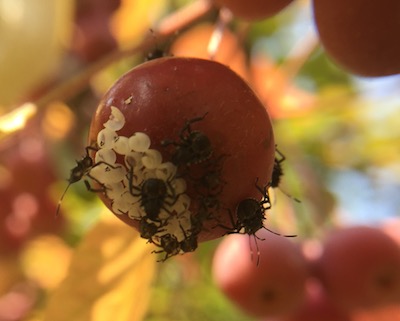 |
 |
Follow me (jmcextman) on FB: https://www.facebook.com/jmcextman
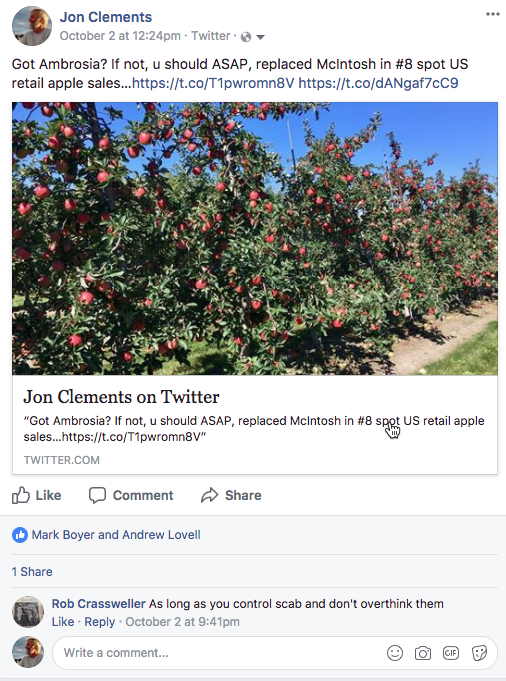
New England Tree Fruit Management Guide
UMass Fruit Advisor: http://umassfruit.com
Scaffolds Fruit Journal: http://www.nysaes.cornell.edu/ent/scafolds/
Network for Environment and Weather Applications (NEWA): http://newa.cornell.edu
Follow me on Twitter (http://twitter.com/jmcextman) and Facebook (http://www.facebook.com/jmcextman)
This will be the last Healthy Fruit for 2017. We hope you have found it useful to produce a profitable crop this year and look forward to having you back in 2018. In the meantime, the UMass Fruit website, umassfruit.com, will be updated with important information that should be of interest to you, so make sure you visit frequently. As always feel free to get in touch with any member of the UMass Fruit Team (http://extension.umass.edu/fruitadvisor/team-members) if you have questions or comments.